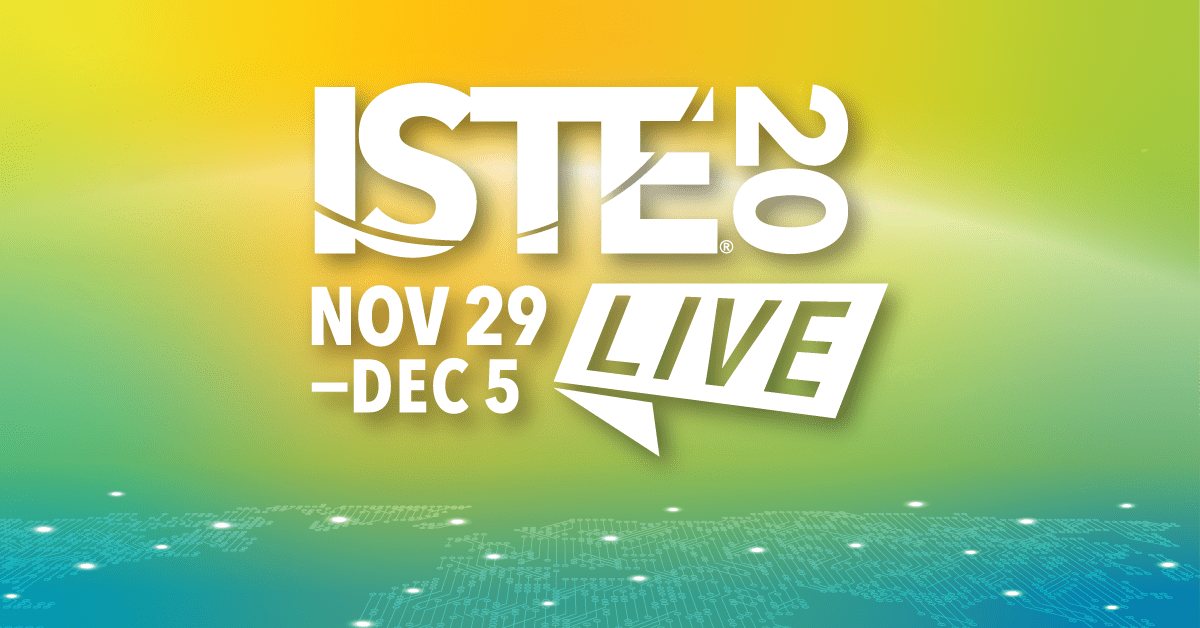Equity & Inclusion

*This post has been written as part of my professional growth plan through my #ISTE20 scholarship.
Why Digital Equity Matters

Presenters: Dr. Desiree Alexander, Darren Bell, Patricia Brown, Keri Hennessy-Wilson, Matthew Hiefield, Carla Jefferson, Valerie Lewis, Dr. Michael Mills, Dr. Adam Phyall
Overview: “As we reimagine and further define digital equity, there’s an increasing need for professional learning opportunities. We’ll facilitate a dialogue about the multiple dimensions of digital equity with the goal of determining actionable steps for K-12 campuses.“
Main Takeaways:
*This was a challenging sessions to participate in the VOD format as the primary component of their session was held via breakout rooms which were not filmed
- “It’s about making sure students hae equal access and opportunity to technology”. This includes devices, software, connectivity, and educators who can move them from consumers to creators.
- Connectivity
- Engagement
- Advocacy
- Performancy advocacy vs. actionable advocacy
Further Resources:
- ISTE Digital Equity PLN page
- ISTE Digital Equity Twitter account
City Mouse, Country Mouse: Addressing Urban/Rural Education Challenges
Presenters: Sean Arnold, Dr. Shawna BuShell, Clint Carlson, Alicia Duell, Cammie Kannekens, Jennifer Maracle-Westgate, Allison Thompson, Dr. Mary Townsend, Dr. Jan Van Gilder
Overview: “There’s a growing divide between urban and rural communities, not just in America, but around the world. And these differences are reflected in our schools. Urban, suburban and rural educators explore the difficult challenges they face and solutions that work in their communities and may help bridge the gap.“
Main Takeaways:
- Rural communities tend to have high levels of communication and community engagement due to close proximity between schools and stakeholders
- All schools are dealing with equity and access concerns for their students
- All schools are working to support adaptability and effective/accessible PD for staff during the pandemic
- Internet access needs to be treated as a utility similar to water and electricity
- Overcommunication while in distance is important at all levels to help ensure clarity
- Logistical constraints due to geography can be removed in the future (more access to guest speakers, more access to course selection, accommodation for student schedules, more access to PD for staff)
Further Resources:
- 6 charts that illustrate the divide between rural and urban America
- The Status of Rural Education
- School Segregation and Disparities in Urban, Suburban, and Rural Areas
- Addressing the unique challenges of urban and rural schools
- Urban Schools Executive Summary
- Rural schools face common challenges, but need unique solutions
- Rural Kids Need Better Schools Too
- Public Opinions on differences between rural, suburban, and urban campuses?
- The Differences Are Huge
- Community Overview
- Differing Circumstances, Shared Challenges
- Why are urban and rural areas so politically divided?
- It’s Not Urban vs. Rural — It’s Suburban vs. Urban
- Rural and Urban Americans, Equally Convinced the Rest of the Country Dislikes Them
- The Growing Urban-Rural Divide Around the World
Instruction and Formative Assessments that Include All Learners
This session was divided into two sections:
- Defeating Digital Distractions
- Formative Assessment

Presenters: Lisa Johnson, Michelle Wendt
Overview: “Make instructional adjustments based on student responses. Using formative assessments, teachers address learning gaps promptly, increase student growth and inform interventions needed for struggling and high-achieving students. Improve questioning skills and explore a variety of tools to assist with assessment and providing timely feedback.”
Main Takeaways:
- Defeating Digital Distractions
- Individual student values impact goals and motivation
- Does technology contribute or hinder you from these values?
- Get students to reflect on technology/social media use, preferences, impacts, etc
- Educate and model being present with students and discuss purposeful use of technology (supported by resources for families and teachers so students are supported at all levels)
- Brainstorm digital and analog tools/strategies to assist students with their memory/understanding
- Social media, streaming, etc detox paired with reflection on how this time made the student feel, pros/cons, next steps
- Instruction & Formative Assessment
- Formative assessment allows you to drive instruction effectively
- Results should lead to differentiation for students
- Priming:
- “preparing the groundwork; establishing and maintaining norms; acting to acculturate students to learning publicly”
- ex: “I bet someone could build on this – who wants to try?
- Posing:
- asking questions that size up the student’s needs (no absolute answers)
- pause between questions and calling on learners
- Pausing
- providing adequate time to think and response (individual or small groups)
- provide manipulatives and resources to utilize during the pause
- Probing
- asking follow up questions that builds off of student responses
- perspective, evidence, conjecture, connections, relevance
- Bouncing
- Sample a variety of responses to see the terrain of student thinking
- Do not comment on a student answer, build dialogue between students
- Tagging
- Visual representation of student responses (chart, word cloud, table, etc)
- Binning
- Categorize student responses: correct, proficient, misconceptions
- Tech tools to support the above strategies:
- Padlet, Peardeck, TriSide, MentiMeter, Miro
- Formative assessment allows you to drive instruction effectively
Further Resources:
- Defeating Digital Distractions companian site (slides, resources, etc)
- Presentation Notes
The next learning topic on my professional growth plan is “Safety, Security, & Student Data Privacy”.